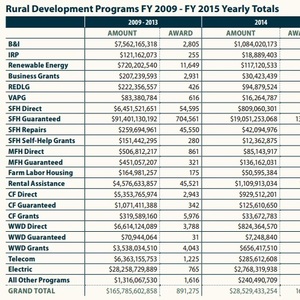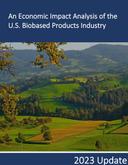USDA report details Rural Development investments




USDA
January 25, 2016
BY Erin Voegele
The USDA has released a report detailing the impacts investments made by its Rural Development team have had on rural America. Bioenergy investments are among those highlighted in the document.
From 2009 to 2015, USDA Rural Development invested nearly $1.1 billion in renewable energy through 15,678 individual awards. These awards include Rural Energy for America Program guaranteed loans and grants; Biorefinery, Renewable Chemical, and Biobased Product Manufacturing Assistance Program loans; and payments made under the Repowering Assistance and Advanced Biofuels Programs. Of that nearly $1.1 billion, $258.75 million was invested in 2015 through 2,675 awards. Approximately $117.12 million was invested in 2014 through 1,354 awards. The remaining $720.2 million was invested through 11,649 awards made from 2009 to 2013.
Advertisement
Advertisement
Last year, more than $244 million was invested through REAP, helping 1,945 farmers, ranchers and rural businesses buy and install renewable energy systems and make energy efficiency improvements.
USDA Rural Development’s Rural Business-Cooperative Service (RBS) provided more than $343 million in guaranteed loans, grants, and advanced biofuel producer payments in 2015. These awards support the development of renewable energy sources, such as advanced biofuels, and helped make rural farms, ranches, dairies, and rural businesses more energy efficient. According to the report, USDA has provided financing and producer payments for more than 11,000 energy projects nationwide since 2009 through $2.1 billion in strategic investments to support rural businesses and American energy independence.
The report also includes data on other non-energy aspects of Rural Development funding, such as housing, telecommunications, and water. In addition. The report breaks down Rural Development investments on a state-by-state basis.
Advertisement
Advertisement
"Over the past seven years, USDA has made record investments in rural America, including housing, infrastructure, business and nutrition, and 2015 was no exception," said Agriculture Secretary Tom Vilsack. "Through our Rural Development agencies alone, USDA was able to support more than 170,000 projects last year, spurring job creation and improving the quality of life for millions of rural Americans. These investments have helped people secure affordable housing and become first-time homeowners, connected America's remote towns with medical providers and business customers via telecommunications, improved critical water and other community facilities, lowered utility costs for residents and businesses through energy efficiency, bolstered local and regional food systems, and created and expanded small businesses. All of this has helped to strengthen local economies for the farmers, families and businesses who call rural America home, and for all Americans who rely on the food, fuel and goods these communities produce."
A full copy of the report can be downloaded from the USDA website.
Related Stories
The U.S. Department of Energy Bioenergy Technologies Office (BETO) announced up to $23 million in funding to support research and development (R&D) of domestic chemicals and fuels from biomass and waste resources.
The U.S. DOE has announced its intent to issue funding to support high-impact research and development (R&D) projects in two priority areas: sustainable propane and renewable chemicals and algal system cultivation and preprocessing.
Sens. Sherrod Brown, D-Ohio, and Pete Ricketts, R-Neb., in August introduced the Renewable Chemicals Act, a bill that aims to create a tax credit to support the production of biobased chemicals.
The Chemical Catalysis for Bioenergy Consortium, a consortium of the U.S. DOE’s Bioenergy Technologies Office, has launched an effort that aims to gather community input on the development of new biomass processing facilities.
USDA on March 8 celebrated the second annual National Biobased Products Day, a celebration to raise public awareness of biobased products, their benefits and their contributions to the U.S. economy and rural communities.
Upcoming Events










